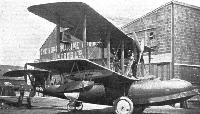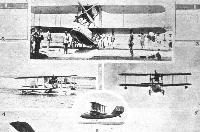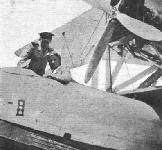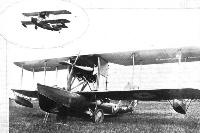
Варианты
- Supermarine - Seal / Seagull - 1921 - Великобритания
- Supermarine - Walrus/Seagull V - 1933 - Великобритания
Supermarine Seagull и Walrus
Облетанный в мае 1921 года, самолет Supermarine Seal II представлял собой трехместную палубную амфибию, предназначенную для использования в качестве корректировщика на авианосцах британских ВМС. В следующем году его переделали в прототип нового самолета Seagull. Последний был выполнен по схеме биплана со складывающимся крылом, а убирающееся колесное шасси обеспечивало ему амфибийные возможности. Самолет был оснащен 480-сильным (358 кВт) ПД Napier Lion II с тянущим винтом, установленным на подкосах между крыльями.
В серию пошел вариант Seagull Mk II, имевший ряд незначительных отличий и оснащенный 492-сильным (367 кВт) ПД Napier Lion IIIB. Экипаж состоял из пилота, наблюдателя и радиста. Стандартное вооружение Seagull - единственный 7,7-мм пулемет Lewis. Всего построили 26 Seagull Mk II, включая один самолет для Японии и три гражданские машины.
Затем было построено шесть Seagull Mk III для Австралии. Они в основном не отличались от британских машин, но оснащались двигателем Napier Lion V такой же мощности. В 1928 году Seagull Mk II прошли доработку, получив предкрылки Handley-Page и двухкилевое оперение. Этот самолет иногда называют Seagull Mk IV, хотя "Supermarine" так и не присвоила ему официального обозначения.
<...>
Описание:
- Supermarine Seagull и Walrus
- Flight, November 1921
THE SUPERMARINE "SEAL," MARK II
Фотографии
-
Мировая Авиация 244
Регистрационный номер: S1123 Southampton Mk I начали поступать на вооружение 480-го (CR) звена британских ВВС в Калшоте с августа 1925 года. Самолет быстро стали использовать для различных известных групповых перелетов на большие дистанции. Так, в ходе экспедиции на Дальний Восток в 1927-1928 годах самолеты преодолели свыше 43450 км.
-
Flight 1921-11 / Flight
The Supermarine "Seal" Amphibian flying boat (450 h.p. Napier "Lion").
-
Flight 1921-11 / Flight
The Supermarine "Seal": Front view of the hull and centre-section, showing amphibian gear.
-
Flight 1921-11 / Flight
The Supermarine "Seal": The machine coming on to the slipway. The wheels have not yet been lowered.
-
Flight 1921-11 / Flight
Регистрационный номер: N146 [2] The Supermarine "Seal": View of the machine taxying. Note the wheel well clear of the water.
-
Flight 1924-05 / Flight
Регистрационный номер: N146 [2] The Supermarine "Seagull" is a deck-landing amphibian fleet spotter with Napier "Lion'' engine. An unusual feature is the tractor airscrew.
-
Flight 1924-08 / Flight
Регистрационный номер: N9605 THE THIRD KING'S CUP RACE, 1924: The Supermarine "Seagull" Amphibian flying boat, 450 h.p. Napier "Lion," two of which are entered in this year's race.
-
Мировая Авиация 244
В Британии Seagull несли службу в 440-м звене (Fleet Reconnaissance) ВВС. Самолет действовал с борта авианосца "Игл".
Supermarine Seagull III. -
Aeroplane Monthly 1990-02 / E.Chilton - Flying starts
A Supermarine Seagull II taking off in 1922, probably from the Solent. The author's first catapult-testing experience, at Farnborough, was in a Seagull with a concrete engine.
-
Flight 1922-06 / Flight
The latest Supermarine Amphibian Flying Boat, photographed during recent tests: In 1 the machine is seen just after getting off, and 2 shows her about to alight. In 3 she is flying over land, with the wheel undercarriage lowered. Note how wheels are lifted well clear of the water when flying over the sea.
-
Flight 1923-03 / Flight
A VISIT TO SOUTHAMPTON: Our photograph shows, from left to right, standing in front of a Supermarine "Seagull," with Napier "Lion" engine, Sir Warden Chilcott, M.P., Commander James Bird, General Bagnall-Wild, Director of Research, the Duke of Sutherland, Under-Secretary of State for Air, Air Vice-Marshal Vyvyan, and Mr. Hubert Scott-Paine.
-
Flight 1922-06 / Flight
THE R.A.F. AERIAL PAGEANT: Interesting machine which will make its first public appearance at the Pageant: The Supermarine "Seagull" (Napier "Lion" ) , an amphibian flying boat.
-
Flight 1927-03 / Flight
Supermarine "Seagull" (Napier "Lion"). The Supermarine "Seagull" is an amphibian-flying boat designed for fleet spotting and reconnaissance. The first of its type was produced in 1921, and it has passed through several series types. While the "Seagull" does not form the standard equipment of any of our home forces, a number are in service with the Royal Australian Air Force, and we have, therefore, included it amongst our resume of types. The "Seagull" has an excellent all-round performance, with a sufficiently low landing speed to allow of deck-landing. The landing wheels are of the retractable type, folding up under the wings.
-
Flight 1926-02 / Flight
"SEAGULLS" FOR AUSTRALIA: These four views show the Supermarine "Seagull," piloted by Captain Biard and carrying as passengers Sir Joseph Cook and Squadron-Leader Brown, taking off, in flight, alighting, and moored to a buoy. Two of these photographs give an indication of the poor visibility obtaining at the time of the flight.
-
Flight 1928-05 / Flight
SURVEYING THE GREAT BARRIER REEF: A composite photograph showing one of the Supermarine-Napier "Seagulls" alighting at Kennedy Sound.
-
Flight 1928-05 / Flight
SURVEYING THE GREAT BARRIER REEF: Supermarine-Napier "Seagulls" were used very successfully for this work. Our photograph shows one of the "Seagulls" alighting off Bowen
-
Flight 1928-05 / Flight
SURVEYING THE GREAT BARRIER REEF: Supermarine-Napier "Seagulls" were used very successfully for this work. Our photograph shows one of the "Seagulls" taxying up the beach on its wheel undercarriage, which proved very useful at low tide.
-
Flight 1928-05 / Flight
A SEAGULL'S NEST: The three Supermarine "Seagulls" housed in their hangar at Bowen. Below, two of them are seen on the tarmac.
-
Flight 1922-11 / Flight
SUPERMARINES IN JAPAN: 1. A "Seagull" amphibian flying boat with Napier "Lion" engine. 2. The "Seagull" taxying. 3. The "Seagull" flying over land. Note the lowered undercarriage. 6. The "Seagull" in flight. Note the gunner's cockpit aft of the planes.
-
Flight 1926-02 / Flight
LAUNCHING THE FIRST AUSTRALIAN "SEAGULL": The upper photograph shows the machine leaving the slipway at Woolston, piloted by Capt. Biard and carrying as passengers Sir Joseph Cook, High Commissioner of Australia, and Squadron-Leader Brown, Liaison Officer of the R.A.A.F. The lower photograph shows Sir Joseph having a final chat with Lady Cook before the start of the flight, and in inset Sir Joseph having his flying cap adjusted.
-
Flight 1926-02 / Flight
CHRISTENING THE FIRST AUSTRALIAN "SEAGULL": At Southampton the christening ceremony and launching of the first of a batch of Supermarine "Seagulls" built for Australia took place on February 6, when Lady Cook christened the machine and Sir Joseph Cook, High Commissioner for Australia, made a flight over the Itchen and Southampton Water. The upper group includes a number of well-known personalities present at the ceremony, and in the lower photographs Lady Cook is seen (on the left) cutting the cord, while on the right the bottle of champagne may be seen at the moment of striking the anchor secured to the bows of the "Seagull."
-
Flight 1930-05 / Flight
THE AIRCRAFT CARRIER IN AUSTRALIA: A Flight of Supermarine - Napier "Seagulls" of the Royal Australian Air Force flying over their Carrier, the "Albatross."
-
Flight 1930-06 / Flight
"SEAGULLS" IN TASMANIA: Our picture shows a fleet of Supermarine Napier ("Lion") "Seagull" amphibian flying-boats of the Royal Australian Air Force flying above Hobart, Tasmania, and gives some idea of the country which these machines have to fly over.
-
Flight 1923-09 / Flight
A Supermarine "Seagull" Amphibian, with Napier "Lion" Engine, at the Naval Base at Tokio: This photograph shows, standing up, Colonel the Master of Sempill, who was originally in charge of the British Aviation Mission to Japan, and, in the cockpit, Major Brackley, who took charge last year. Major Brackley is reported to have been on his way to England at the time of the terrible earthquake. All members of the British Aviation Mission are now reported to be safe.
-
Flight 1923-11 / Flight
VISITORS INSPECTING THE MACHINES AT CROYDON ON SATURDAY: The machines in the foreground are a Supermarine "Seagull," a Parnall "Plover," and an Avro "Aldershot," with 1,000 h.p. Napier "Cub."
Другие самолёты на фотографии: Avro Aldershot / Type 549 - Великобритания - 1922Parnall Plover - Великобритания - 1922
-
Flight 1927-05 / Flight
HAMPSHIRE AIR PAGEANT: The Amphibian Element. Two views of the Supermarine "Sheldrake" (Napier "Lion")
-
Aeroplane Monthly 1979-10 / D.Brown - Wings over Sussex (2)
Регистрационный номер: G-EBXH One of three FAA Supermarine Seagull IIIs converted between 1928-9, G-EBXH worked along the south coast.
-
Flight 1921-11 / Flight
Supermarine "Seal" Mk II Napier "Lion" Engine
- Фотографии




























